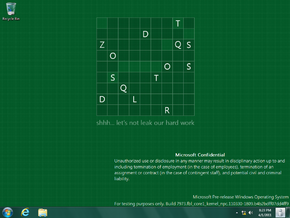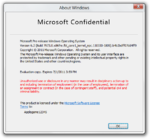Windows 8 build 7973 (fbl_core1_kernel_npc)
| Build of Windows 8 | |
 | |
| OS family | Windows NT |
|---|---|
| Version number | 6.2 |
| Build number | 7973 |
| Build revision | 0 |
| Architecture | x86 |
| Build lab | fbl_core1_kernel_npc |
| Compiled on | 2011-03-30 |
| Expiration date | |
| Timebomb | 2011-07-01 (+93 days) |
| About dialog | |
Windows 8 build 7973 (fbl_core1_kernel_npc) is a build of Windows 8, which was uploaded to BetaArchive on 19 September 2015.[1]
Editions and keys[edit | edit source]
| Edition / SKU | Key |
|---|---|
| Starter | 7Q28W-FT9PC-CMMYT-WHMY2-89M6G |
| Home Basic | YGFVB-QTFXQ-3H233-PTWTJ-YRYRV |
| Home Premium | RHPQ2-RMFJH-74XYM-BH4JX-XM76F |
| Professional | HYF8J-CVRMY-CM74G-RPHKF-PW487 |
| Ultimate | D4F6K-QK3RD-TMVMJ-BBMRX-3MBMV |
Changes[edit | edit source]
- Updated the boot screen to include the fish from the wallpaper of Windows 7 builds 6910 to 7231 and a boot spinner, albeit at a slightly larger size compared to later builds.
- Changed the startup kernel font from Lucida Console to Segoe Mono Boot.
- The system crash screen font has been changed from Segoe UI to Segoe WP.
- The boot manager entry is now named "Windows 8" as opposed to "Windows 7".
- The early crash screen now includes parameters consisting of four different bugcodes.
Redpill[edit | edit source]
- The Start screen is starting to look vastly different from the previous builds, with the design of the tiles being changed to a look that more closely resembles its final design.
- The Immersive Control Panel has been redesigned.
- The splash screen for MS Help has been changed to a rather crude one done in Microsoft Paint.
- The Metro folder icons and thumbnails seen in build 7970 have been disabled and can no longer be enabled.
Bugs and quirks[edit | edit source]
Advanced Vector Extensions CPU bug[edit | edit source]
Some copies of this build will not boot on some CPUs with the Advanced Vector Extensions (AVX) instruction set due to a bug where a CPU triple fault occurs immediately after the boot screen is first displayed. A workaround is discussed later in the article.
This problem can also present itself as three bugchecks occurring one after the other, with different error codes overwriting each other on the screen.
App tiles[edit | edit source]
Some app names (such as Control Panel, Chess Titans, Defragment and Optimize Drives, etc) may be truncated by normal sized tiles.
Upgrade[edit | edit source]
This build does not correctly copy the required installation binaries to the temporary Windows installation boot directory ($WINDOWS.~BT) that are required to proceed to the next phase of the upgrade process. Upgrades must instead be performed using the older setup user located in the installation media's sources directory or by using another build's setup components.
Aero[edit | edit source]
Only the top portion of the window frame is blurred when using the Windows Aero and Aero Lite themes, leaving the side borders transparent.
Pseudo language pack[edit | edit source]
In this build, the pseudo language pack is present, and it can be installed. This is caused by improper cleanup of the pseudo language pack while staging the build, resulting in leftover files.
Compiler[edit | edit source]
This is one of the first builds to be produced using a new compiler. However, the problems surrounding it at that time resulted in the build becoming unbootable on certain hardware, as the boot loader does not properly function on modern x86 CPUs, namely Intel processors with the AVX instruction set and a select number of AMD CPUs. As a result, a CPU triple fault occurs resulting in either a crash on a hypervisor or a reboot on real hardware.
Most of the bugs found in this build are a side effect of the new compiler.
Patching winload.exe to run on Intel processors with AVX[edit | edit source]
In order to properly enable SSE instructions for machines using Intel processor with AVX, the 9th bit in Control Register 4 (CR4) must be turned on. The following code is executed and is located in winload.exe at offset A042:
mov eax, cr4 ; 0f20e0
or eax, 20h ; 83c820 -- Turn on 5th bit, PAE (Physical Address Extension)
mov cr4, eax ; 0f22e0 -- Store it in CR4
mov eax, cr0 ; 0f20c0
or eax, 80000000h ; 0d00000080 -- Enable paging
mov cr0, eax ; 0f22c0
By default the following bits are set in CR0: Protected Mode (PE) (0x00000001), Monitor co-processor (MP) (0x00000002) and Extension type (ET) (0x00000010), with no bits in CR4 set initially, so the need to turn on the 9th SSE bit (i.e. OR with 0x600) should be done, but due to limitation in this piece of code, a rewriting needs to be done and the following approach may be used instead:
mov eax,620h ; b820060000
mov cr4,eax ; 0f22e0
mov eax,80000013h ; b813000080
mov cr0,eax ; 0f22c0
nop ; 90
nop ; 90
nop ; 90
nop ; 90
As a disclaimer, patching winload.exe with these changes will invalidate integrity checks and thus requires Test Mode to be enabled (by setting NoIntegrityChecks in the BCD to on) in order to boot with the patched winload.exe, as well as ownership of the file in both %systemroot%\System32 and %systemroot%\System32\Boot need to be altered in case file replacement was not possible.
Compatibility[edit | edit source]
VMware Workstation[edit | edit source]
For another workaround on the Intel SSE bug that does not involve patching and disabling security checks, the compatibility level must be set to version 7.x or lower in order to boot this build. In addition, the following block of code must be added to the VMX (virtual machine configuration) file in order to allow this build to boot on modern Intel CPUs:
cpuid.0.ebx = "0110:1000:0111:0100:0111:0101:0100:0001"
cpuid.0.ecx = "0100:0100:0100:1101:0100:0001:0110:0011"
cpuid.0.edx = "0110:1001:0111:0100:0110:1110:0110:0101"
cpuid.1.eax = "0000:0000:0000:0001:0000:0110:0111:0001"
The above configuration is mostly not required if the host machine has an AMD processor, and as such only requires the compatibility version to be changed.
Gallery[edit | edit source]
Setup[edit | edit source]
Interface[edit | edit source]
Redpill-specific[edit | edit source]
Immersive Internet Explorer































